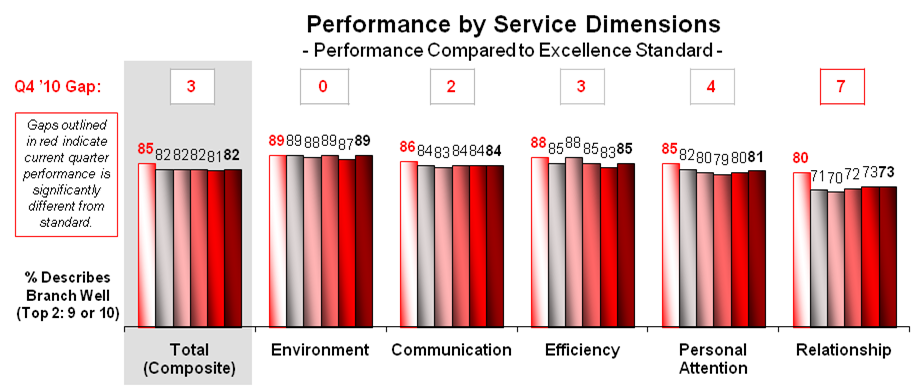As individuals, we strive to be better humans – healthier, happier and morally balanced. In the same way, the organizations we lead need a clear path to excellence and to continued growth. Every organization needs a mechanism to guide it on the right path, one that helps set goals, develop priorities, and monitor success. One tool for doing this is a Customer Scorecard that assesses how well you are doing in meeting the critical needs of customers. The scorecard has broad applicability, but it is particularly valuable in areas where financial measures (say, profit and loss) do not apply. This includes non-profit membership associations, government agencies, and internal service units.
Case Study 1 – Credit Union: the institution monitors performance in meeting member needs through a survey for all its major touch-points, such as branch visits and call center transactions. Customers are surveyed continuously and results are rolled up quarterly and annually into a scorecard. A gaps-based model (rooted in SERVQUAL) is used to identify standards of excellence for goal setting. The results are used to drive improvements and reward management.
A Customer Scorecard is based on ongoing feedback from customers, members or constituents through a survey tool. Ultimately, the scorecard provides a single metric, but includes many useful components to aid management:
- Performance ratings on multiple criteria that focus on meeting customer needs. These should be developed from talking to customers or to staff who are knowledgeable about customer needs.
- Expectation ratings on the same performance criteria, providing a soft standard you should strive to meet. For example, an organization may rate 75% in satisfaction in “caring about customers” but need to get to 85% to meet their expectations.
- Priorities for improvement identified by quantifying how important each performance area is and comparing it to the “gap” in meeting expectations (in the bullet above, the gap is 85 minus 75, or 10 points). To achieve optimal success, the organization should focus on areas with the biggest gaps that are most important.

Case Study 2 – Non-Profit: a leading trade association, faced with declining membership during a recession, wanted to set clear direction for its staff and member leaders. We developed a list of 20 core member needs based on brainstorming with staff and volunteers, and implemented a tracking survey that rolls up the numbers into a single performance metric. The scorecard identifies where priorities need to be set (e.g., new programs, education, advocacy) and tracks improvement each year.
A Customer Scorecard is not only a valuable scientific tool, but an effective way of gaining consensus and mobilizing the organization around a common strategy. To illustrate, an internal service/support unit of a global technology company developed a scorecard based on criteria agreed to by its own staff and its internal customers. The unit became more effective because it was given goals that were clear, measureable, related to customer needs, and accepted by all.
The process requires many methodological steps before the first report is on a CEO’s desk. This includes qualitative research to identify customer expectations and a baseline study that quantifies performance and expectations. An effective scorecard also organizes performance criteria into dimensions – for example, a non-profit scorecard may include areas such as “professional development,” “sector leadership,” “networking and forums,” and “information and tools.” The sub-dimensions help the organization achieve a more strategic view.
Ultimately, any organization wants to achieve its own form of happiness, which leads to growing sales or membership, satisfied customers, and a sound reputation. A Customer Scorecard is a powerful tool for achieving this success.
Written by: Charles Colby, Chief Methodologist
